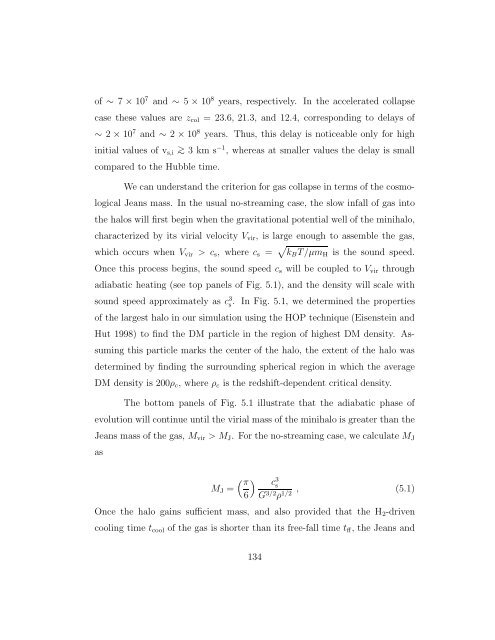Copyright by Athena Ranice Stacy 2011 - The University of Texas at ...
Copyright by Athena Ranice Stacy 2011 - The University of Texas at ...
Copyright by Athena Ranice Stacy 2011 - The University of Texas at ...
Create successful ePaper yourself
Turn your PDF publications into a flip-book with our unique Google optimized e-Paper software.
<strong>of</strong> ∼ 7 × 10 7 and ∼ 5 × 10 8 years, respectively. In the acceler<strong>at</strong>ed collapse<br />
case these values are zcol = 23.6, 21.3, and 12.4, corresponding to delays <strong>of</strong><br />
∼ 2 × 10 7 and ∼ 2 × 10 8 years. Thus, this delay is noticeable only for high<br />
initial values <strong>of</strong> vs,i > ∼ 3 km s −1 , whereas <strong>at</strong> smaller values the delay is small<br />
compared to the Hubble time.<br />
We can understand the criterion for gas collapse in terms <strong>of</strong> the cosmo-<br />
logical Jeans mass. In the usual no-streaming case, the slow infall <strong>of</strong> gas into<br />
the halos will first begin when the gravit<strong>at</strong>ional potential well <strong>of</strong> the minihalo,<br />
characterized <strong>by</strong> its virial velocity Vvir, is large enough to assemble the gas,<br />
which occurs when Vvir > cs, where cs = kBT/µmH is the sound speed.<br />
Once this process begins, the sound speed cs will be coupled to Vvir through<br />
adiab<strong>at</strong>ic he<strong>at</strong>ing (see top panels <strong>of</strong> Fig. 5.1), and the density will scale with<br />
sound speed approxim<strong>at</strong>ely as c3 s . In Fig. 5.1, we determined the properties<br />
<strong>of</strong> the largest halo in our simul<strong>at</strong>ion using the HOP technique (Eisenstein and<br />
Hut 1998) to find the DM particle in the region <strong>of</strong> highest DM density. As-<br />
suming this particle marks the center <strong>of</strong> the halo, the extent <strong>of</strong> the halo was<br />
determined <strong>by</strong> finding the surrounding spherical region in which the average<br />
DM density is 200ρc, where ρc is the redshift-dependent critical density.<br />
<strong>The</strong> bottom panels <strong>of</strong> Fig. 5.1 illustr<strong>at</strong>e th<strong>at</strong> the adiab<strong>at</strong>ic phase <strong>of</strong><br />
evolution will continue until the virial mass <strong>of</strong> the minihalo is gre<strong>at</strong>er than the<br />
Jeans mass <strong>of</strong> the gas, Mvir > MJ. For the no-streaming case, we calcul<strong>at</strong>e MJ<br />
as<br />
MJ =<br />
<br />
π<br />
<br />
6<br />
c3 s<br />
G3/2 , (5.1)<br />
ρ1/2 Once the halo gains sufficient mass, and also provided th<strong>at</strong> the H2-driven<br />
cooling time tcool <strong>of</strong> the gas is shorter than its free-fall time tff, the Jeans and<br />
134









